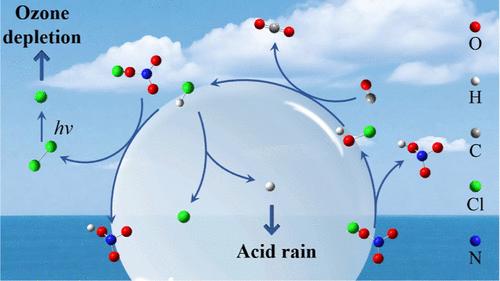Molecular Insights into the Spontaneous Generation of CO2 in Reaction of CO and HOCl at Air–Water Interfaces
IF 15.6
1区 化学
Q1 CHEMISTRY, MULTIDISCIPLINARY
引用次数: 0
Abstract
The final step for CO in fossil fuel combustion and tropospheric chemistry is its conversion to CO2 via ·OH oxidation, which represents a major source of greenhouse gas emissions and has been extensively studied. However, the mechanisms for CO-to-CO2 transformation beyond ·OH-mediated pathways in the troposphere remain poorly understood. Herein, we identify a novel atmospheric CO2 generation pathway driven by a heterogeneous reaction between CO and HOCl at air–water interfaces, which operates independently of ·OH. Using ab initio molecular dynamics, we elucidate a stepwise mechanism: (i) coordination of the HO moiety of HOCl with the C atom of CO, forming a HOCO intermediate, followed by (ii) Cl atom transfer to the C center accompanied by simultaneous release of HCl and (iii) dissociation of the formed HCl. The reaction exhibits a remarkably low free-energy barrier (ΔGTS = 13.6 kcal mol–1) at approximately 300 K. More importantly, ΔGTS decreases with decreasing temperature. When the temperature decreases to 243 K, the reaction is almost spontaneous (ΔGTS = 1.7 kcal mol–1). These findings have further important implications for understanding acid rain formation and O3 depletion mechanisms.

CO和HOCl在空气-水界面反应中自发生成CO2的分子研究
化石燃料燃烧和对流层化学中CO的最后一步是通过·OH氧化将其转化为CO2,这是温室气体排放的主要来源,已被广泛研究。然而,对流层中CO-to-CO2转化的机制仍然知之甚少。在此,我们确定了一种新的大气CO2生成途径,该途径由空气-水界面CO和HOCl之间的非均相反应驱动,该反应与·OH无关。利用从头算分子动力学,我们阐明了HOCl的HO部分与CO的C原子配位,形成HOCO中间体,然后是(ii) Cl原子转移到C中心,同时释放HCl和(iii)形成的HCl解离。该反应在约300 K时表现出非常低的自由能垒(ΔGTS = 13.6 kcal mol-1)。更重要的是,ΔGTS随着温度的降低而降低。当温度降至243 K时,反应几乎是自发的(ΔGTS = 1.7 kcal mol-1)。这些发现对进一步理解酸雨的形成和O3耗竭机制具有重要意义。
本文章由计算机程序翻译,如有差异,请以英文原文为准。
求助全文
约1分钟内获得全文
求助全文
来源期刊
CiteScore
24.40
自引率
6.00%
发文量
2398
审稿时长
1.6 months
期刊介绍:
The flagship journal of the American Chemical Society, known as the Journal of the American Chemical Society (JACS), has been a prestigious publication since its establishment in 1879. It holds a preeminent position in the field of chemistry and related interdisciplinary sciences. JACS is committed to disseminating cutting-edge research papers, covering a wide range of topics, and encompasses approximately 19,000 pages of Articles, Communications, and Perspectives annually. With a weekly publication frequency, JACS plays a vital role in advancing the field of chemistry by providing essential research.

 求助内容:
求助内容: 应助结果提醒方式:
应助结果提醒方式:


